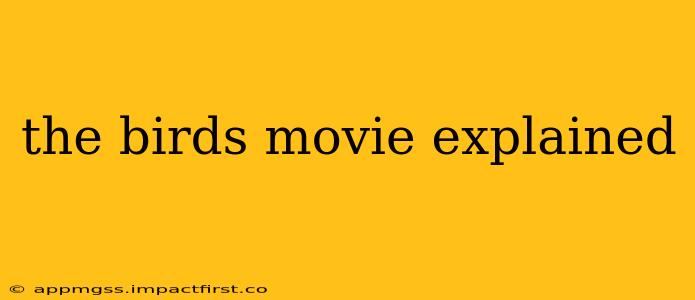Alfred Hitchcock's The Birds (1963) remains a chilling masterpiece, less a straightforward horror film and more a study of escalating dread and inexplicable terror. While the plot is relatively simple, the film’s power lies in its unsettling atmosphere, ambiguous narrative, and lingering questions about its meaning. This exploration will delve into the film's plot, symbolism, and enduring mystery, addressing common audience questions.
What is The Birds About?
At its core, The Birds tells the story of Melanie Daniels (Tippi Hedren), a wealthy San Francisco socialite, who embarks on a seemingly innocent pursuit of a young man, Mitch Brenner (Rod Taylor), in Bodega Bay, a small coastal town. Her arrival coincides with a series of increasingly aggressive bird attacks, starting with seemingly playful pecking and escalating to terrifying, coordinated assaults on humans and animals. The film follows Melanie, Mitch, his mother, and other townspeople as they struggle to survive the escalating avian onslaught, the birds' motives and the reasons behind their behavior remaining completely unexplained.
What Happens at the End of The Birds?
The film culminates in a horrifying siege on the Brenner family's home, as thousands of birds relentlessly attack. The survivors—Melanie, Mitch, his mother, and a young boy—find themselves trapped and overwhelmed, desperately seeking shelter and refuge. The film ends abruptly, leaving the audience to grapple with the survivors' uncertain future amidst the seemingly endless avian assault. There's no clear resolution; the attacks continue, leaving the fate of the characters and the town itself ambiguous and unsettling.
Why do the birds attack in The Birds?
This is perhaps the most frequently asked question, and the film's brilliance lies in its refusal to provide a definitive answer. The lack of explanation enhances the film's unsettling nature. Several interpretations exist:
-
Environmental disaster: Some posit that the birds' attacks are a consequence of environmental damage or disruption, possibly triggered by unseen factors affecting the birds' behavior.
-
Metaphor for societal anxieties: Others see the birds as a manifestation of the Cold War anxieties and societal uncertainties of the time, reflecting a sense of impending doom and the fragility of civilization. The birds' irrationality mirrors the irrationality of conflict and fear.
-
Psychological horror: The unexplained nature of the attacks adds to the psychological tension, emphasizing the helplessness of the characters in the face of an incomprehensible threat.
What are the birds' motives in The Birds?
As mentioned, the film never explicitly explains why the birds attack. This lack of explanation is crucial to its lasting impact. It forces the audience to confront their own anxieties and fears, projecting their own interpretations onto the events unfolding on screen.
What is the symbolism in The Birds?
Hitchcock masterfully employs symbolism throughout the film:
-
Birds as a symbol of nature's power: The birds represent the untamed forces of nature, demonstrating the vulnerability of humanity in the face of overwhelming, unpredictable power.
-
Melanie as an outsider: Melanie's arrival in Bodega Bay foreshadows the disruption and chaos that follow.
-
The birds' escalating aggression: The increasing intensity and organization of the attacks represent the growing threat, reflecting a sense of escalating doom.
Is there a sequel to The Birds?
No, there is no official sequel to Alfred Hitchcock's The Birds. While there have been various attempts at adaptations and related projects, none are considered official continuations of Hitchcock's original masterpiece.
The Birds remains a powerful and unsettling cinematic experience, its enduring legacy stemming from its masterful use of suspense, its ambiguous narrative, and its exploration of humanity's vulnerability in the face of the unknown. The lack of a clear explanation for the bird attacks fuels ongoing discussion and interpretation, solidifying its place as a classic of the horror genre.
